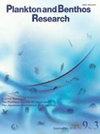Long-term dynamics of the macrozoobenthos in the Kytai Lake (Danube River, Odessa region, Ukraine)
IF 0.9
4区 生物学
Q4 MARINE & FRESHWATER BIOLOGY
引用次数: 0
Abstract
Species composition and quantitative characteristics of the macrozoobenthos in the Kytai Lake were studied. During 2006–2012, 272 macrozoobenthic samples were collected from the littoral and sublittoral zones of the lake. A total of 66 species were identified in the collected samples. In 2006–2009, the number of species increased from the upper to the lower reaches of the lake, with all 66 species recorded in the latter. However, with increasing salinity and decreasing dissolved oxygen content, the total number of macrozoobenthic species dropped up to 12 in 2012, with the highest number observed at the lower reaches. The average annual macrozoobenthic abundance and biomass in the littoral zone (836±33.08 ind. m−2 and 19.7±0.78 g m−2, respectively) were comparable to those in the sublittoral zone (879±35.16 ind. m−2 and 9.19±0.36 g m−2, respectively). In summer 2012, during the period of maximum development, the macrozoobenthic abundance and biomass in the littoral zone were 346 ind. m−2 and 3.26 g m−2, respectively. The Shannon-Weaver diversity index reached 3.26 bits ind−1 in the littoral zone in 2006–2008 and then decreased to 2.34 bits ind−1 in 2010–2012. The Pielou evenness indices during these periods were 0.66 and 0.61, respectively. In August 2009–2012, the correlation coefficient between salinity and macrozoobenthic abundance was −0.97. In July 2006– 2012, the correlation coefficient between dissolved oxygen content and macrozoobenthic biomass was 0.89, whereas that between dissolved oxygen content and macrozoobenthic species number was 0.95. Results of the correlation and multiple regression analyses revealed the key role of oxygen depletion in decreasing the macrozoobenthic species richness and its development. Principal component analysis indicated that the first two principal components, related to transparency, oxygen, salinity, and temperature, explained most of the total variance of the data. Transparency, oxygen, and temperature positively influenced the macrozoobenthic species composition and quantitative characteristics, whereas salinity exerted a negative influence.乌克兰敖德萨地区多瑙河基泰湖大型底栖动物的长期动态
研究了Kytai湖大型底栖动物的种类组成和数量特征。在2006年至2012年期间,从该湖的沿岸和海底带采集了272个大型底栖动物样本。在采集的样本中共鉴定出66个物种。在2006–2009年,物种数量从上游增加到下游,所有66种物种都记录在下游。然而,随着盐度的增加和溶解氧含量的降低,2012年大型底栖动物物种的总数下降到12种,其中下游的数量最多。滨海带的年平均大型底栖动物丰度和生物量(分别为836±33.08 ind.m−2和19.7±0.78 g m−2)与海底亚带的(分别为879±35.16 ind.m–2和9.19±0.36 g m–2)相当。2012年夏季,在最大发育期,沿岸带的大型底栖动物丰度和生物量分别为346 ind.m−2和3.26 g m−2。2006–2008年,Shannon Weaver多样性指数在沿海地区达到3.26位ind−1,然后在2010–2012年降至2.34位ind–1。这些时期的Pielou均匀度指数分别为0.66和0.61。2009-2012年8月,盐度与大型底栖动物丰度之间的相关系数为-0.97。2006–2012年7月,溶解氧含量与大型底栖动物生物量的相关系数为0.89,而溶解氧含量和大型底栖动物物种数量的相关系数则为0.95。相关和多元回归分析结果揭示了缺氧在降低大型底栖动物物种丰富度及其发育中的关键作用。主成分分析表明,与透明度、氧气、盐度和温度有关的前两个主成分解释了数据的大部分总方差。透明度、氧气和温度对大型底栖动物物种的组成和数量特征有积极影响,而盐度则有负面影响。
本文章由计算机程序翻译,如有差异,请以英文原文为准。
求助全文
约1分钟内获得全文
求助全文
来源期刊

Plankton & Benthos Research
Agricultural and Biological Sciences-Aquatic Science
CiteScore
1.30
自引率
0.00%
发文量
32
期刊介绍:
Plankton and Benthos Research is a peer-reviewed journal publishing quarterly original papers, reviews and notes dealing with any aspect of the biology and ecology of planktonic and benthic organisms and their interactions with the environment in any aquatic system, and is open to all scientists around the world. Submission of a paper is held to imply that it represents an original contribution not previously published and that it is not being considered elsewhere.
 求助内容:
求助内容: 应助结果提醒方式:
应助结果提醒方式:


